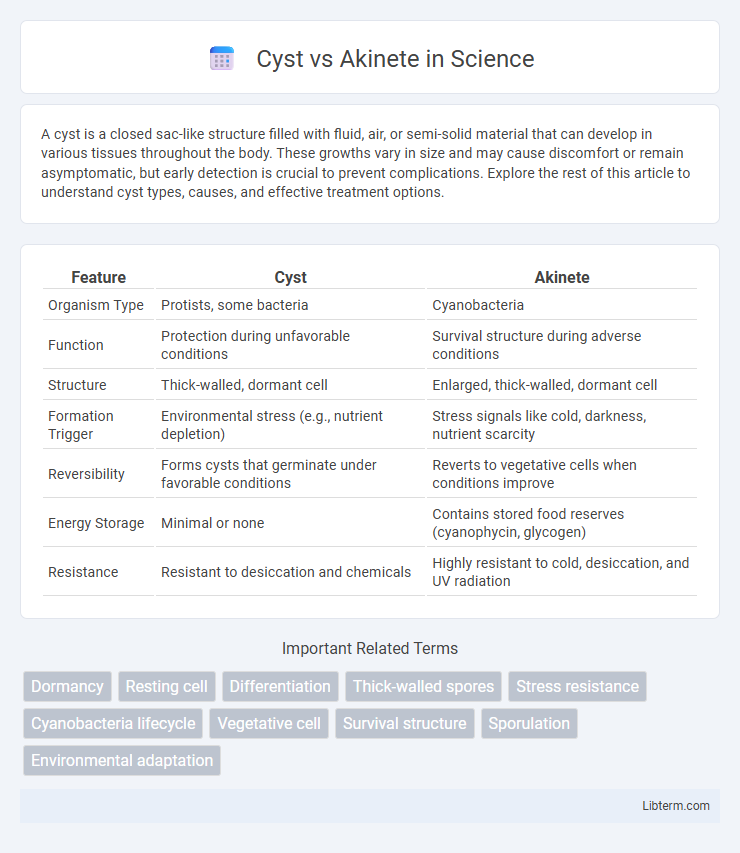A cyst is a closed sac-like structure filled with fluid, air, or semi-solid material that can develop in various tissues throughout the body. These growths vary in size and may cause discomfort or remain asymptomatic, but early detection is crucial to prevent complications. Explore the rest of this article to understand cyst types, causes, and effective treatment options.
Table of Comparison
| Feature | Cyst | Akinete |
|---|---|---|
| Organism Type | Protists, some bacteria | Cyanobacteria |
| Function | Protection during unfavorable conditions | Survival structure during adverse conditions |
| Structure | Thick-walled, dormant cell | Enlarged, thick-walled, dormant cell |
| Formation Trigger | Environmental stress (e.g., nutrient depletion) | Stress signals like cold, darkness, nutrient scarcity |
| Reversibility | Forms cysts that germinate under favorable conditions | Reverts to vegetative cells when conditions improve |
| Energy Storage | Minimal or none | Contains stored food reserves (cyanophycin, glycogen) |
| Resistance | Resistant to desiccation and chemicals | Highly resistant to cold, desiccation, and UV radiation |
Introduction to Cyst and Akinete
Cysts are dormant, thick-walled structures formed by various microorganisms, including algae and protozoa, that enable survival under adverse environmental conditions. Akinetes are specialized, enlarged, and nutrient-rich resting cells produced primarily by cyanobacteria to endure periods of cold, nutrient scarcity, or desiccation. Both cysts and akinetes play essential roles in microbial life cycles by facilitating dormancy and resilience, yet they differ in origin, structure, and specific adaptive functions.
Definition of Cyst
A cyst is a dormant, resistant structure formed by certain microorganisms to survive unfavorable environmental conditions, characterized by a thick protective wall. Unlike akinetes, which are specific to certain cyanobacteria and function primarily as resting cells, cysts occur in a wider range of organisms including protozoa and bacteria. The cyst's ability to protect the organism during harsh environments ensures survival and facilitates dispersal.
Definition of Akinete
An akinete is a thick-walled, dormant cell formed by certain filamentous cyanobacteria for survival under adverse environmental conditions, characterized by the accumulation of nutrients and enhanced resistance to desiccation and cold. Unlike cysts, which are commonly formed by protozoa and serve as a protective resting stage, akinetes function primarily as overwintering cells ensuring species persistence. These specialized cells play a crucial role in the lifecycle of cyanobacteria by enabling regrowth when favorable conditions return.
Structural Differences Between Cyst and Akinete
Cysts are single-celled, dormant structures with thickened walls that form in response to unfavorable environmental conditions, often characterized by a polymer-rich matrix providing resistance to desiccation and chemical damage. Akinetes are specialized, enlarged vegetative cells surrounded by multiple layers of thickened cell wall containing stored nutrients like glycogen and cyanophycin, which enable survival during prolonged stress such as cold or nutrient depletion. Structural differences include cysts having a simpler, uniformly thick wall primarily for protection, while akinetes possess multilayered walls with granules and cellular inclusions for both protection and energy storage.
Formation Process of Cysts and Akintes
Cysts form through a process involving the thickening of the cell wall and encasement of the organism in a protective, dormant state to survive unfavorable environmental conditions. Akinetes develop specifically in filamentous cyanobacteria by enlarging certain vegetative cells, accumulating food reserves, and thickening their cell walls to endure stress such as cold or nutrient scarcity. The formation of cysts is a general survival strategy in various microorganisms, whereas akinetes represent a specialized adaptation primarily in cyanobacteria.
Biological Roles and Functions
Cysts serve as protective structures in various microorganisms, enabling survival under adverse environmental conditions by entering a dormant state. Akinetes, found specifically in cyanobacteria, function as specialized resting cells that facilitate persistence during nutrient depletion and harsh climates by storing nutrients and thickening cell walls. Both cysts and akinetes play crucial roles in life cycle regulation, stress resistance, and population maintenance in their respective organisms.
Environmental Triggers for Formation
Cysts in microorganisms typically form in response to adverse environmental conditions such as nutrient depletion, desiccation, or temperature extremes, enabling survival during unfavorable periods. Akinetes, found predominantly in certain cyanobacteria, develop primarily due to environmental stressors like cold temperatures, reduced light, and nutrient limitation, serving as resistant spores for overwintering. Both structures represent adaptive strategies triggered by specific stress signals that induce dormancy and enhance resistance to environmental challenges.
Survival Strategies in Unfavorable Conditions
Cysts in protozoa and akinetes in cyanobacteria serve as survival structures enabling endurance under unfavorable conditions such as nutrient depletion or desiccation. Cysts possess resistant walls that protect dormant protozoan cells, facilitating reactivation when conditions improve, while akinetes are enlarged, thick-walled spores that store nutrients and resist environmental stress. Both adaptations enhance microbial persistence by minimizing metabolic activity and safeguarding cellular integrity against harsh environments.
Examples in Bacterial and Algal Species
Cysts are dormant, resistant structures formed by bacteria like Azotobacter and algae such as Spirogyra to survive unfavorable conditions. Akinetes are specialized thick-walled spores found in filamentous cyanobacteria like Anabaena and Nostoc, enabling long-term survival during nutrient depletion. Both adaptations enhance survival but differ in structure and function within bacterial and algal species.
Summary: Key Differences and Significance
Cysts are dormant, thick-walled survival structures formed by certain bacteria, fungi, and protozoa to withstand unfavorable conditions, while akinetes are specialized, enlarged dormant cells produced by filamentous cyanobacteria for long-term survival. Akinetes contain stored nutrients and thicker cell walls compared to cysts, enabling enhanced resistance to environmental stress such as cold and desiccation. Understanding the key differences between cysts and akinetes is crucial for studying microbial life cycles, ecological resilience, and the management of harmful algal blooms caused by cyanobacteria.
Cyst Infographic

 libterm.com
libterm.com